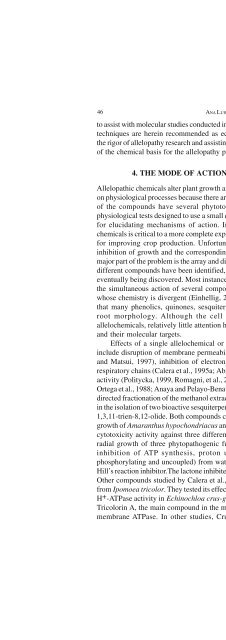Allelochemicals Biologica... - Name
Allelochemicals Biologica... - Name
Allelochemicals Biologica... - Name
You also want an ePaper? Increase the reach of your titles
YUMPU automatically turns print PDFs into web optimized ePapers that Google loves.
46<br />
ANA LUISA ANAYA<br />
to assist with molecular studies conducted in today’s expanding field. Such instrumental<br />
techniques are herein recommended as economically efficient means of advancing<br />
the rigor of allelopathy research and assisting the development of a better understanding<br />
of the chemical basis for the allelopathy phenomenon (Haig, 2001).<br />
4. THE MODE OF ACTION OF ALLELOCHEMICALS<br />
Allelopathic chemicals alter plant growth and development by a multiplicity of actions<br />
on physiological processes because there are hundreds of different structures and many<br />
of the compounds have several phytotoxic effects. Whole plants bioassays and<br />
physiological tests designed to use a small quantity of compound are keys to strategies<br />
for elucidating mechanisms of action. Insight into the action of the responsible<br />
chemicals is critical to a more complete explanation of allelopathy and to its application<br />
for improving crop production. Unfortunately, we still find that linkages between<br />
inhibition of growth and the corresponding physiological mechanism are elusive. A<br />
major part of the problem is the array and diversity of allelochemicals. Several hundred<br />
different compounds have been identified, and we speculate that many others will be<br />
eventually being discovered. Most instances of allelopathic inhibition are the result of<br />
the simultaneous action of several compounds, and often these include compounds<br />
whose chemistry is divergent (Einhellig, 2002). The visible evidence in bioassays is<br />
that many phenolics, quinones, sesquiterpene lactones, alkaloids, and others alter<br />
root morphology. Although the cell membrane is an early interface with<br />
allelochemicals, relatively little attention has been given to membrane-related effects<br />
and their molecular targets.<br />
Effects of a single allelochemical or their mixtures on physiological processes<br />
include disruption of membrane permeability (Galindo, et al., 1999), ion uptake (Yu<br />
and Matsui, 1997), inhibition of electron transport in both the photosynthesis and<br />
respiratory chains (Calera et al., 1995a; Abrahim, et al., 2000), alteration of enzymatic<br />
activity (Politycka, 1999, Romagni, et al., 2000), and inhibition of cell division (Cruz-<br />
Ortega et al., 1988; Anaya and Pelayo-Benavides, 1997). In other examples, bioactivitydirected<br />
fractionation of the methanol extract of the roots of Ratibida mexicana resulted<br />
in the isolation of two bioactive sesquiterpene lactones, isoalloalantolactone and elema-<br />
1,3,11-trien-8,12-olide. Both compounds caused a significant inhibition of the radicle<br />
growth of Amaranthus hypochondriacus and Echinochloa crus-galli, exerted moderate<br />
cytotoxicity activity against three different solid tumour cell lines and inhibited the<br />
radial growth of three phytopathogenic fungi. Isoalloalantolactone also caused the<br />
inhibition of ATP synthesis, proton uptake, and electron transport (basal,<br />
phosphorylating and uncoupled) from water to methylviologen therefore acting as a<br />
Hill’s reaction inhibitor.The lactone inhibited only photosystem II (Calera et al., 1995b).<br />
Other compounds studied by Calera et al., (1995c) were the resin glycoside mixture<br />
from Ipomoea tricolor. They tested its effect on seedling growth and plasma membrane<br />
H + -ATPase activity in Echinochloa crus-galli. The resin glycoside mixture as well as<br />
Tricolorin A, the main compound in the mixture, inhibited the activity of the plasma<br />
membrane ATPase. In other studies, Cruz-Ortega et al. (1998) observed plasma


